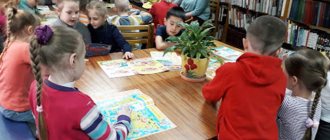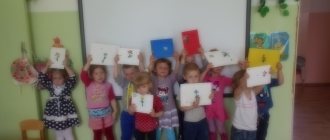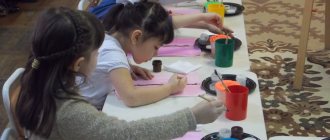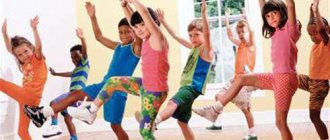Artistic development of preschool children in preschool educational institutions
Artistic and aesthetic education plays a special role in the life of a preschooler.
Important ! It is worthwhile to instill in a child a sense of beauty from early childhood and teach him to understand works of art.
Artistic education of children through the use of fine arts
The younger age of children makes them more receptive to the visual arts, which has a direct impact on artistic education. Artistic development is the ability to evaluate works of art, understand them, experience emotions from contact with them and create independently.
Kids need to be developed
It is important for preschoolers (preferably from the age of 1) to familiarize themselves with all types of fine arts as self-education:
- Sculpture is a work performed in volume in various ways.
- Painting is an image made with paints on a plane.
- Architecture - the creation of buildings and structures.
- Graphics is an image on a plane without color, using lines, strokes, and dots.
- Decorative arts are the decoration of something.
Children love paintings
It is also important to familiarize yourself with the various materials, of which there are different types:
- pencils;
- gel pens;
- ink and pen;
- gouache paints;
- watercolor;
- oil;
- acrylic;
- oil and dry pastels;
- coal;
- sanguine;
- markers;
- paper;
- clay;
- plasticine;
- marble;
- metals;
- glass;
- gypsum and many others.
Conditions for the successful development of a child’s visual activity
Artistic education is an integral part of human upbringing. The conditions for the successful development of a child’s visual activity include:
- Support by the teacher (in the absence of pressure on the process).
- Help in developing the imagination of a preschooler.
- Freedom to use materials for creativity.
- Awareness of the existence of various techniques and materials.
- Family assistance in the development of the child (family as a role model).
Kids love to decorate the kindergarten area
Aesthetic education in a kindergarten
Aesthetic education is designed to teach a preschooler:
- see beauty around;
- understand and appreciate art;
- reach for beauty.
The first place in aesthetic education in preschool educational institutions is occupied by the design of the territory of the kindergarten and its premises. This is the first thing a child sees when coming to kindergarten.
The area should be well-groomed, flowers should be planted in the summer, borders should be whitewashed, and garbage should be removed. The room where the group is located should not be cluttered, colorful or dark and gloomy.
It is important to maintain harmony in color; aesthetics is needed in the details. A library with beautiful illustrated books is needed in every group. Hanging reproductions of paintings or illustrations will be of great benefit.
Early development according to the Montessori method - what is it?
Contemplation of nature is no less important. The teacher should teach this to the preschooler during walks. Example: pay attention to:
- insects (beautiful butterflies, hardworking ants, nimble dragonflies);
- dew on the grass;
- the first yellowed leaves;
- red bunches of rowan;
- early arrival of winter.
Note ! All this trains children's minds, develops their taste, and makes them more attentive.
We conduct a master class on artistic and aesthetic development
The master class “Swan Fidelity” (finger painting) will be useful.
Type: practical lesson.
Equipment: thick A3 paper, pencil, eraser, gouache, brushes, water jar, table.
Objective: to introduce preschoolers to a new drawing technique, to develop imagination and creativity.
Duration: one academic hour.
Progress:
- “Guys, you probably know about the existence of such birds as swans. They are very beautiful and graceful. They have a flexible, long neck. They come in white and black. They differ in that they create a pair for life. And if one swan dies, then the second may die of melancholy.”
- “Today we will draw a couple of these swans. But we will paint the birds themselves not with a brush, but with our palms! This is such a visual device.”
- “Take a piece of paper and lay it horizontally.”
- “Using a simple pencil, outline the background on which you will have the swans (an island in the water, water, grass, sandy shore).”
- “Next, use a large brush and paints to fill the background with color.”
- “You will need to depict swans like this: take black or white gouache.”
- “Apply a thick layer of paint to each palm separately and stamp the palms so that the swan heads (thumbs) are reaching towards each other.”
- “Press your index, middle, ring and little fingers together. Look what a cool drawing it turns out."
- “Small ones can be improved with a thin brush or fingers. Look how unusual the swans turned out!
Collective development is a priority
Artistic and aesthetic development of preschool children: concept, tasks and principles
Tatiana
Artistic and aesthetic development of preschool children: concept, tasks and principles
Aesthetic development occupies one of the leading places in the content of the educational process of a preschool educational institution. Currently, this area is highlighted as a priority along with the intellectual and physical development of children .
Aesthetic education
- this is the organization of the life and activities of children, contributing to the development of the child’s aesthetic feelings, the formation of ideas and knowledge about the beauty in life and art, aesthetic assessments and an aesthetic attitude towards everything that surrounds us.
For the aesthetic development artistic activities - musical, visual, artistic - speech, etc. - are of great importance . An important task of aesthetic education is the development of children’s aesthetic interests, needs, as well as aesthetic taste and abilities.
The great Russian teacher K. D. Ushinsky considered the aesthetic in human behavior as a form of manifestation of his morality. The boundaries between the moral and the aesthetic are arbitrary. By educating aesthetically, we improve a person’s moral qualities, his ideas about good and evil, duty and honor, conscience, and friendship. This is the main meaning of aesthetic education.
Back in the 70s of the twentieth century, generally positively assessing the system of aesthetic education in preschool development could not be built : the essence of aesthetic development , its difference from art , the role of living conditions and everyday life, the relationship between various educational means.
The entire range of questions put forward by the author is closely interconnected.
What is commonly understood today by artistic development , which, modeling various manifestations of life, is capable of clearly revealing aesthetic and spiritual value through art?
M. S. Kogan in the book “Human Theory of Values”
defines
artistic education based on an understanding of artistic culture . In his opinion, artistic culture is :
1) the universal space of artistic activity , that is, it covers all its various manifestations - literary, musical, stage and plastic, cinema, etc.;
2) artistic artificial artistic common to the whole world - a certain idea of the world and man, and then a creative method and artistic style in which these ideas are embodied;
3) artistic culture is a historically changing way of social organization of all artistic activity .
Based on this understanding of artistic culture , artistic education in the broad sense of the word is a way of including an individual in the artistic culture of society .
Artistic education involves:
1) fostering a love of art and artistic taste
2) development in the child of certain practical skills (drawing, singing, imagining, dancing)
3) imparting to the child certain knowledge in the field of theory and history of a particular type of art.
Artistic education
- purposeful activity aimed at wider inclusion of the individual in the artistic life of society . The solution to this problem has 2 levels :
1. To introduce the individual to contemporary art in all the diversity of its species and genre forms.
2. Introducing the individual to the artistic heritage , to the diversity of its historical layers, starting from ancient times and including the artistic culture of all peoples of the world.
This structure of artistic education is explained by the fact that great art survives the time of its creation and enters as a necessary component into the artistic culture of each new era; in the same way, the art of each people belongs to all humanity , organically entering the life of other peoples.
Artistic education involves the unification of three areas of educational activity:
1. Artistic education in the narrow sense of the word, i.e. the education of artistic taste as a psychological mechanism capable of ensuring an adequate perception of art and the formation of artistic consciousness - views , positions, ideals.
2. Art education , aimed at expanding a person’s knowledge in the field of history and theory of art.
3. Artistic education , designed to develop artistic creativity in one or more areas of art (regardless of whether a person becomes a professional or an amateur)
.
Aesthetic education
- a concept much broader than artistic . It is not limited to the sphere of art, much less to any one type of art, or to one of the possible forms of corresponding activity. The aesthetic culture of a person presupposes the development of his entire sensory sphere ( “aesthetic”
means
“sensual”
, emotionally responding to diverse natural phenomena and the most diverse aspects of reality. The main criterion here is the presence of a sense of beauty.
In the aesthetic education of children, the leading activity is artistic . Education, during which the artistic development of children , has great opportunities, but the process of assimilation of artistic experience is always individual. Acquaintance with art, introducing children to artistic activities is one of the ways of personality formation, the development of its inclinations and qualities, .
At the same time, by development we will understand a special type of change that is irreversible and necessarily involves qualitative transformations.
Aesthetic education is a complex and lengthy process. Aesthetic education is understood as the purposeful development in a person of an aesthetic attitude to reality, “the formation of a creatively active personality, capable of perceiving , feeling, appreciating the beautiful, tragic, comic, ugly in life and art, living and creating according to the laws of beauty.”
The main tasks of aesthetic education in domestic pedagogy are considered to be :
1. Education and development of a person’s aesthetic perception, aesthetic feelings, emotions, experiences, education of aesthetic taste, i.e. the ability to understand beauty in life and art.
2. Aesthetic taste is expressed in a value judgment. It reflects a certain aesthetic ideal, which testifies to a person’s ability to understand the essence of beauty.
3. Development of an aesthetic attitude to reality: the ability and desire to bring beauty into the surrounding life
According to N. A. Vetlugina, the formation of an aesthetic attitude to reality, which begins in early childhood, is of particular importance. A child’s aesthetic attitude to the environment includes his emotional response to beauty, his creative activity, the desire to appreciate harmonious combinations of colors, sounds, etc. A. A. Melik-Pashaev defines aesthetic attitude as a special perception and assessment of the surrounding life; as an artistic practice for children ; as an adequate perception of works of art.
The main means of artistic education is art itself, the experience of direct communication with it. The task of teachers is to organize this experience. Only then does the effect of artistic education when art has aesthetic value. That is why “ artistic and aesthetic education are tied into one knot.” [26, p.18] Therefore, the term “ artistic and aesthetic education ” is legitimate.
At preschool age, children receive their first artistic impressions and master various types of artistic activities . A characteristic feature of the interpretation of aesthetic education in kindergarten is that it is a purposeful process, organized into a single system and meeting the requirements of the comprehensive and harmonious development of the child .
N. A. Vetlugina in the theory of aesthetic education of preschoolers notes the importance of a systematic approach and defines its main features:
a) the integrity of aesthetic education as a substructure of comprehensive education and development ;
b) the determining role of educational and educational tasks development of the child ;
c) the totality of all means of education and forms of organizing the artistic activity of a child with the leading role of an adult;
d) mutual influence of parts of this subsystem.
Each of the listed characteristics has a certain place in the process of personality formation.
Describing a systematic approach to the aesthetic education of preschool , N. A. Vetlugina writes that all components of aesthetic education are closely interconnected, although some are leading and determining, others are more derivative. They influence the personality of each child as a whole, passing through the prism of his needs, interests, age and individual capabilities. It is very important, the author points out, that the teacher’s work in this direction is built on a scientific basis and carried out according to a specific program that takes into account the current level of development of art , in compliance with the principle of gradualism , consistent complication of requirements, a differentiated approach to the knowledge and skills of children of different ages.
In this regard, the tasks of the aesthetic education system listed above should include (according to I. F. Kharlamov)
and such as:
– formation of aesthetic needs in the field of art;
– students’ mastery of knowledge related to understanding art and the ability to express their judgments on issues of artistic reflection of reality;
– introducing children to artistic creativity , revealing their inclinations and abilities.
The system of artistic and aesthetic education and development is an organic part of universal human education; its organization, as noted by I. F. Kharlamov, is based on the following basic principles .
1. The principle of the organic connection of all artistic and aesthetic activities of children with life, the practice of renewing society (its essence is that the aesthetic phenomena of life and high art, organically connected with the life being transformed, form an aesthetic attitude to reality). Aesthetic education is not limited to the sphere of art, and especially to any one of its types. Aesthetic education should occur continuously and everywhere during the acquisition of knowledge, in the process of teaching the skills of any activity, in all contacts of the child with the environment.
2. The principle of unity of artistic and general mental development ( artistic and aesthetic activity ensures intensive development of children’s imagination , their emotional sphere, memory, speech, thinking).
3. The principle of consistency presupposes the constant improvement of aesthetic feelings, tastes, expansion of the emotional sphere, etc.
4. The principle of aestheticization of the entire child’s life requires the organization of relationships, activities, and communication of children according to the laws of beauty.
these principles with those that emphasize the uniqueness of artistic and aesthetic education and development of preschool children . In the “Creativity” program, for example, developed by a team of authors under the leadership of A. I. Smolyar, the artistic and aesthetic education and development of preschool children is built in accordance with the principles : taking into account the child’s play experience and his development in play activities; conformity with nature; creating an artistic and creative space ; complexity.
All the prerequisites for the artistic and aesthetic development developed and strengthened in it . The artistic potential of a child’s play experience is enormous; play experience is the main factor in the artistic and aesthetic development of children . A separate paragraph in this chapter will be devoted to this.
The principle of conformity with nature involves taking into account the nature of the child and the nature of art ( preschool childhood is valuable in itself , this is one of the most important stages in a child’s life).
The principle of creating an artistic and creative environment through joint aesthetic activity and active communication. The description of the environment as a factor in artistic and aesthetic development will be devoted to material in the second chapter of our work.
In artistic and aesthetic development, complexity is understood as the unity of different types of activity, in which the following conditions are met:
a) scientifically based content and methods;
b) implementation of the tasks of moral , mental, physical and aesthetic education and development ;
c) the emergence of new opportunities and ways of artistic exploration of reality, enriching children with various ways of conveying figurative content, awareness of search situations, and the formation of creative abilities.
The principle of complexity is manifested in the fact that the content of work with children is built in accordance with a single goal ( the development of an aesthetic attitude to the world, has the same psychological prerequisites, the general focus of creative tasks and games , is revealed through thematic unity, and is expressed in the methodological strategy of conducting classes. The process is artistic - aesthetic education and development of the child (children)
is built in such a way that art becomes the basis of the child’s life activity and life creativity.
The complexity of education presupposes the solution of all current problems of the systemic organization of artistic and aesthetic education and development , including the implementation of the principle of continuity as one of the fundamental principles in the formation and development of the education system of the younger generation. Improving continuity in the process of artistic and aesthetic education is facilitated by the close connection between the complex of pedagogical influences in preschool educational institutions and at school and the process of artistic and aesthetic development of children . Continuity involves the use of the most effective forms, means and methods of artistic and aesthetic education ; identifying new forms and means, based on the achieved level of artistic and aesthetic development of children . The significance of this problem is now especially increasing in connection with the creation of experimental programs in various types of art (fine art, music, as well as complex ones.
So, we can draw some conclusions.
Aesthetic development is a much broader concept than artistic development . It is not limited to the sphere of art, much less to any one type of art, or to one of the possible forms of corresponding activity.
The main means of artistic development is art itself, the experience of direct communication with it. The task of teachers is to organize this experience. Only then does the effect of artistic development when art has aesthetic value. Therefore, we can talk about the unity of artistic and aesthetic development .
The main tasks of artistic and aesthetic development from our point of view are:
• development of a person’s aesthetic perception;
• development of aesthetic taste;
• development of an aesthetic attitude to reality;
• fostering a love of art and artistic taste ;
• development of certain practical skills in the child (drawing, singing, imagining, dancing)
;
• imparting to the child certain knowledge in the field of theory and history of a particular type of art;
• wide inclusion of the individual in the artistic life of society ;
• familiarization of the individual with contemporary art in all the diversity of its species and genre forms;
• familiarization of the individual with the artistic heritage , with the diversity of its historical layers.
The principles of artistic and aesthetic development of preschool children are:
• the principle of an organic connection between all artistic and aesthetic activities of children with life and the practice of renewing society;
• the principle of unity of artistic and general mental development ;
• principle of consistency;
• the principle of aestheticization of the entire child's life;
• the principle of taking into account the child’s gaming experience and his development in gaming activities;
• principle of conformity with nature;
• the principle of creating an artistic and creative space;
• principle of complexity.
An analysis of the literature on developmental psychology allowed us to identify age-related characteristics that need to be based on in experimental work on the artistic and aesthetic development of children . They are as follows: children's animism, increased impressionability and susceptibility; non-standard and not lost primacy of perception; tentatively - the exploratory nature of sensory processes; sufficiently developed motor memory ; visual-figurative thinking (as a new development of preschool age )
; the beginning of the emergence of creative imagination; the ability to act consciously and voluntarily.
Features of the development of technical creativity in preschool children
Technical creativity teaches a preschool child not only perseverance and patience, but also helps to develop certain abilities:
- The ability to find non-standard solutions to the tasks assigned to them and select a means for these solutions.
- Plan your activities.
- Compare, find differences and similarities, generalize.
- Select parts and combine them into a whole.
- Analyze your actions step by step, draw conclusions, give an account of your actions, assume further options for the development of events, correct shortcomings, identify advantages and use them in the future.
Mathematics classes for preschoolers aged 6-7 years
In addition, preschoolers learn to interact with each other, gain experience working in a team, learn to negotiate, look for a way out of the current situation, and develop their imagination.
Note ! The main type of activity of a preschooler according to the Federal State Educational Standard is play, which is inextricably linked with a toy. One follows from the other: a toy gives rise to play activity, and by developing play activity, it attracts new toys. Therefore, it is better to engage in technical creativity with little ones through play. The game helps to captivate the preschooler, interest him and achieve the desired result.
The best option for technical creativity of kids are:
- magnetic constructors;
- building kits;
- various cubes;
- block constructors;
- modeling kits;
- constructors with joint fastening;
- bolt-on constructors.
Innovative technologies in preschool educational institutions to unlock the creative potential of preschoolers
Innovative technologies in kindergarten are the use of modern components to improve the educational process.
The main types of innovative technologies in preschool educational institutions include:
- Project activities. The project is developed together with the teacher, helps the preschooler acquire new knowledge and systematize existing knowledge. The projects themselves are classified according to several criteria.
- Personality-oriented technologies. The teacher’s task is to select methods, games and activities that allow a particular child to develop as much as possible.
- Information and communication technologies. Consists of using personal computers, projectors, tablets, interactive whiteboards and other things in the classroom. The technology helps to attract kids. They are developing new skills. With it you can watch educational videos, films, cartoons. Improves educational process and presentation.
- Health-saving technologies. They consist of conducting thematic conversations, morning exercises, physical education sessions, sports festivals and other sporting events.
- Research activities. A research paper is similar to a course project. Teaches a preschooler to explore the world around him, understand the task at hand, find the problem and give it a definition. The main activity in this case is an experiment that contributes to the development of the baby’s thinking.
- Corrective technologies. Aimed at relieving emotional tension in the group. Relaxing music, color therapy, special games and exercises can be used.
- Gaming technologies. They occupy a dominant role due to the fact that play is the main activity of preschool children. At the same time, the game has a cognitive and developmental function.
The artistic and aesthetic development of a preschooler helps to make the child a comprehensively developed personality, capable of appreciating and seeing the beauty around him, and creating beauty with his own hands.
What it is?
In pedagogy, the artistic and aesthetic development of a preschooler is understood as the formation of the ability to perceive the beauty of the surrounding world, as well as the development of the ability to show creative activity.
These qualities are developed in a child already in preschool age.
Artistic and aesthetic development performs the following tasks:
- Develops the emotional sphere of the child’s inner world.
- Helps accumulate aesthetic knowledge and standards.
- Forms the ability to enjoy aesthetic objects, as well as express one’s own attitude towards them.
- Develops abilities in the creative field.
These goals are achieved through various forms and types of aesthetic development.
Conversations are held with preschoolers on topics about the sublime and beautiful.
Communication with nature, which is an inexhaustible source of beauty, plays a big role.
In addition, it is important how the space in which children are is organized; it also has educational significance.
Preschoolers directly participate in a variety of creative activities - drawing, dancing, music, crafts, etc. In holidays and games, children embody artistic ideas that they became acquainted with during the learning process.
There are various forms of organizing artistic and aesthetic development:
- Games.
- Training sessions.
- Exhibitions.
- Excursions.
- Holidays.
IMPORTANT! It is necessary to select the form and type of activity in the artistic and aesthetic sphere in accordance with the age and interests of the students. The goals that the teacher strives for should be taken into account.
Activities to develop abilities in preschool age
There is a huge variety of creative activities that contribute to the development of artistic perception of preschoolers, who vary in age and type of creativity.
Classes for 3-4 years
REFERENCE! At this age, babies are just learning to express a positive reaction when they see familiar objects. They are not yet ready to perceive an artistic image, but choose certain pictures simply because they like them or resemble familiar objects.
One of the effective ways to develop artistic and aesthetic skills in children of primary preschool age is unconventional drawing. This provides an incentive to develop the ability to think outside the box and experiment. The arsenal of unconventional drawing is very diverse:
- Drawing with stencils - in this case, paint is applied to a pre-prepared stencil using a variety of tools: a sponge, a brush, a roller or even ordinary rags.
- Drawing with stamps, palms, leaves, cotton swabs, etc. - in this case, paint is applied to a stamp or something that replaces it and an impression is made on paper. Prints can be formed into patterns, and you can experiment with color.
- Drawing on wet paper differs from regular drawing in that paint is applied to a pre-moistened sheet and it spreads, creating unexpected patterns. At the same time, the child learns to follow what happens and guide the drawing process.
Modeling from plasticine not only forms artistic and aesthetic perception, but also promotes the development of fine motor skills, which is very important in preschool age. To deepen the effect of these activities, plasticine figures sculpted by children are used to dramatize fairy tales.
IMPORTANT! Musical classes can be either an independent form of creativity or accompany the creative process in other directions. For example, when a teacher turns on music while drawing or sings songs with children while dramatizing fairy tales.
Classes for 5-7 years old
REFERENCE: At the age of 5, a child is already able to receive aesthetic pleasure from contemplating a painting, but for him the color scheme is more important than the composition. At the age of 6-7 years, perception becomes much more subtle, children capture the inner mood of the image.
At this age, the possibilities for creative activities with children expand, as the children’s abilities also expand.
Older preschoolers have more complex skills and can complete more complex tasks.
For example, children 6-7 years old can engage in floristry, quilling, papermaking, etc.
Floristry is the creation of compositions from plant materials. It requires the child to be able to see the image, select the necessary shapes and shades of colors, and carefully work with fragile material.
For work, you can use leaves, flowers, twigs, moss and other plant materials.
Quilling is the making of pictures from rolled strips of paper. This is a rather painstaking task that requires patience and perseverance. Artistically, children learn to compose a composition and select colors.
Papermaking is an excellent tool for developing imaginative thinking. By making three-dimensional models from paper, preschoolers solve design problems, show imagination and aesthetic taste. Additionally, paper craft activities can be complemented by storytelling, drama, and other forms of creative development.
IMPORTANT! In older preschool age, children begin to get acquainted with the masterpieces of world artistic culture - paintings, architecture, literature (fairy tales, poems), etc. This happens in the form of conversations, viewing photographs, and reading.







